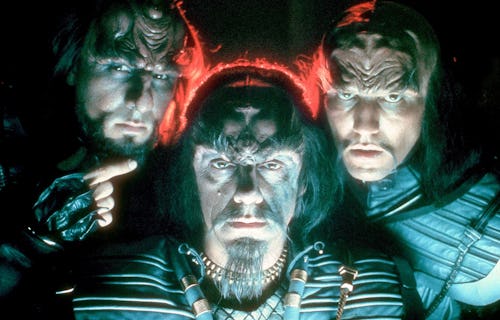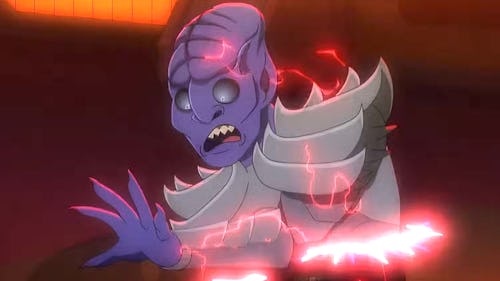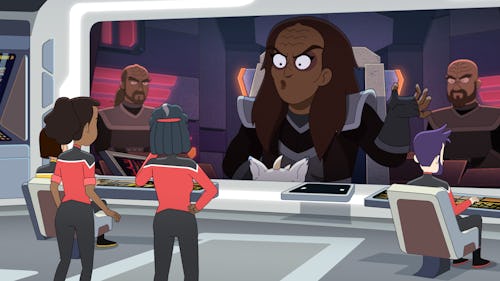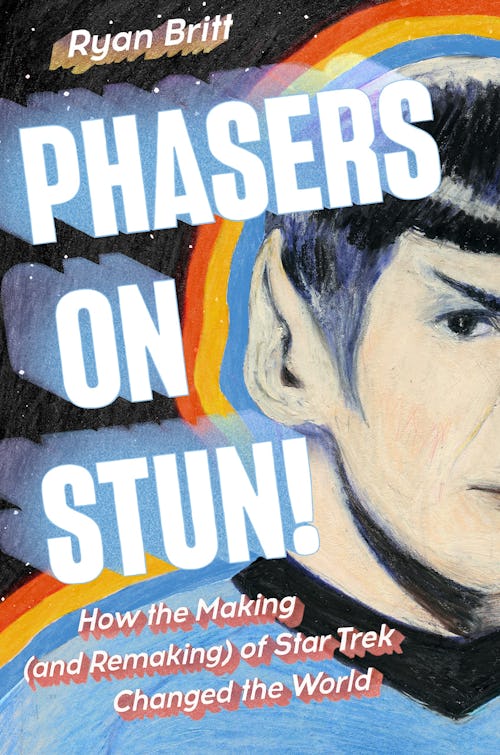
Ever since the opening moments of Star Trek: The Motion Picture, the canonicity of how Klingons are supposed to look became a whole thing. Prior to 1979, the Klingons of Star Trek: The Original Series were smooth-headed, but after 1979, they all had the big, bumpy lobster foreheads. And by 1984, with The Search for Spock, there were a variety of different Klingon foreheads, which got even more diverse in the era of The Next Generation. From there, Klingon forehead canon settled down, more or less, until 2017 — that’s when Star Trek: Discovery debuted entirely new Klingons, which didn’t look much like any of the Klingons from before.
Now, in the recently-aired finale of Star Trek: Lower Decks, the Discovery-era Klingons are briefly seen side-by-side with the more familiar TNG-era Klingons. But was Lower Decks trying to suggest those other Klingons are from a different continuity? Here’s what happened, and why it doesn’t mean what some of the haters might think.
Spoilers for Star TrekL Lower Decks ahead.
In the series finale of Lower Decks, “The New Next Generation,” the crew of the Cerritos has to prevent the multiverse from collapsing. Briefly, this results in a chase through a rift rife with soliton particles, which results in the Cerritos transforming into various different versions of itself, for different realities. But before that happens, a 24th-century Klingon Bird-of-Prey is transformed into the style of Klingon ships featured in the 23rd century of Discovery Season 1, and one of the Klingons morphs into the the bald, more monstrous claw-handed Klingons from that era, too.

So was Lower Decks saying that the Discovery-era Klingons — and therefore all of Discovery — exists in an alternate dimension? The short answer is no. The rift was impacting time as well as space, which is why one of the other Klingon ships was transformed into a sailing ship. Furthermore, Lower Decks can’t possibly exist in an alternate continuity separate from Discovery, and that’s because Lower Decks directly crossed over with Strange New Worlds in 2023. Technically, Strange New Worlds is a Discovery sequel and takes the majority of its continuity from the events of the DISCO Season 2 finale, “Such Sweet Sorrow Part II.”
That said, Klingon canon has been extremely confusing as of late. At the start of Strange New Worlds Season 2 debut, “The Broken Circle,” the Klingons reappeared, looking very much how fans would expect them to look. And then, during flashbacks to the Discovery-era Klingon War in the SNW episode “Under the Cloak of War,” the Klingons fighting in that war retroactively looked like the SNW versions of the Klingons, rather than the DISCO Klingons. Speaking to Inverse at the start of SNW Season 2, co-showrunner Henry Alonso Myers said this:
“The history that nobody talks about is that in almost every show, there has been a change in the way the Klingons look. And what Discovery did was really interesting and it was specific and it was challenging. This was our chance to say that we were not changing or ruining anything that anyone else has done, but to do something that felt like its own, but very much coming from the world of the other Klingons.”
Myers is right. Even from The Motion Picture through The Undiscovered Country, there are some inconsistencies in how Klingons are portrayed. In Deep Space Nine’s 1996 episode, “Trials and Tribble-ations” Worf attempted to lampshade this by saying, “We do not discuss it with outsiders.”
But in 2005, in the Enterprise episodes “Affliction” and “Divergence,” an explanation was offered: Some Klingons in the 22nd century were infected with a genetic virus that made their foreheads less bumpy. This didn’t explain the existence of the more monster-ish Klingons from Discovery, but it did create a precedent that there are various different types of Klingons that have existed in different forms, for several centuries. (One early theory was that T’Kuvma’s Klingons in Discovery were an earlier, purer form of Klingons from the distant past. Though there’s no official confirmation of this.)

In the same interview from 2023, SNW’s other showrunner, Akiva Goldsman said, “I worked on Discovery and I’ll just say, it’s nice to have those Klingons in the rearview mirror.”
So, why did Lower Decks include these controversial Klingons? Well, for one thing, LDS showrunner Mike McMahan is a force unto himself and has frequently said that Lower Decks represents love for all the various eras of Star Trek. In 2020 he told Inverse: “Lower Decks ends up becoming the Rosetta Stone of all the different Star Trek properties, including the Kelvin movies and everything can be unified through Lower Decks.”
Discovery-style T-shirts with the abbreviation “RITOS” have been seen on Cerritos crewmembers for a while now. In all likelihood, the appearance of the Discovery Klingons was the last chance Lower Decks had to tip its hat to that show. Discovery kicked off the era of Trek that resulted in Lower Decks existing, and in 2024, both shows aired their final episodes. Not to mention, Lower Decks Season 5 had already mad a Discovery connection by bringing back Mary Chieffo — previously L’Rell on DISCO — as a very different kind of Klingon.
We may never get a full breakdown of why different types of Klingons have existed at different times. But if we ever did, what would be the fun in that?
Star Trek: Lower Decks and Star Trek: Discovery stream on Paramount+.
FTTT

0 Comments